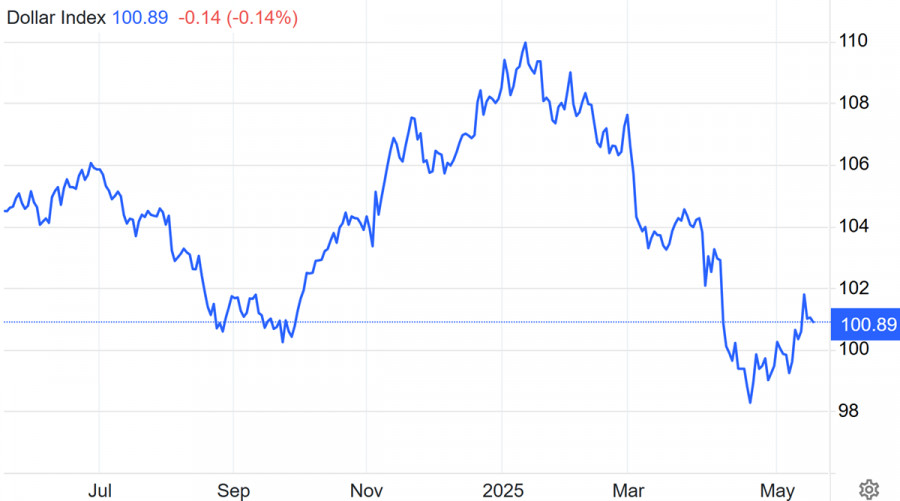A new phase is beginning in the currency market, where economic fundamentals and geopolitical strategy shape the U.S. dollar's exchange rate. The U.S. administration is subtly considering the idea of a weaker dollar, though unofficially. Officially, no one admits anything. Unofficially, every gesture is interpreted as a hint.
Bloomberg reports, citing sources within the White House, that all authority over currency policy is held by Treasury Secretary Bessent. He is the sole individual authorized to discuss foreign exchange matters with international partners, positioning him as a key figure in a precarious situation. While he publicly states that there is no intention to weaken the dollar, he is, in practice, steering policy in that direction.
This kind of duality is textbook. Openly announcing a devaluation would crash the markets. However, creating an environment where the dollar "naturally" loses value is a far more elegant strategy. U.S. trade policy over recent months has revolved around this very approach.
And the market senses it. The yuan's decline, the drop in the Taiwanese dollar, and subtle cues from trading floors in Switzerland are puzzle pieces in which a weaker dollar becomes a bargaining chip for trade concessions from partners. While officials insist FX wasn't discussed, Citibank insiders quietly suggest otherwise: FX is what everyone is concerned about—it's not officially on the agenda.
However, this game of silence has its downside. If the market fully believes the U.S. is deliberately pursuing dollar devaluation, participants will stop making long-term bets on its strength.
As confidence wanes, capital flees. And with non-residents increasingly abandoning dollar hedging, even small political signals can trigger significant sell-offs.
That's why Societe Generale analysts argue that Trump is objectively interested in a cheaper dollar. It fits his strategy of restructuring global trade and using the currency as a tool of economic pressure.
The more the U.S. uses the dollar as a political instrument, the less attractive it becomes as a reserve asset.
In summary, the dollar's weakness is not coincidental; it results from a shift in U.S. policy. In the coming weeks, traders will be especially attentive to every statement from Bessent and any actions taken by the Fed. Even a subtle hint could trigger a new wave of dollar decline.
Opinion: The Dollar Returns to Fundamentals – The Sell-Off May Be a False Start
Not everyone believes in the dollar's weakness. According to analysts at Lombard Odier, the recent sell-off of the U.S. dollar and American assets was not a collapse, but a healthy market correction that opens up new tactical opportunities.
Michael Strobaek, global CIO at the Swiss private bank, notes that U.S. bond yields remain among the most attractive in the world, and the dollar has already returned to a fair-value range relative to major currencies such as the euro, yen, and franc.
The spike in yields following the "liberation sell-off" has created favorable conditions for short-term longs. The dollar, down nearly 6% since the start of the year, has begun to stabilize and, according to Lombard Odier, is no longer overvalued. This suggests that "sell America" may not be the beginning of a long-term trend, but rather an emotional, swift, and—as now evident—temporary response to the tariff shock.
The bank states that if trade tensions continue to ease, as seems to be happening with China and the UK, the dollar will again be supported by classic drivers—interest rate differentials, real yield levels, and economic surprises.
This return to fundamentals could emerge as the next theme in the market. Once the initial turmoil subsides, valuation models—rather than political headlines—will come to the forefront. That means the dollar hasn't said its last word—especially if the Fed doesn't rush to cut rates and global investors continue chasing yield.
Therefore, Lombard Odier's perspective serves as a reminder not to underestimate the dollar: although it may be facing pressure at the moment, it still possesses strong advantages in the long run.
Short-Term Outlook for USD: Between Powell and Soft Data
On Thursday, the dollar finds itself at the center of conflicting signals: on one hand, Jerome Powell's hawkish rhetoric; on the other, a string of weak macroeconomic reports that fuel hopes for Fed policy easing. This divergence increases volatility and reflects a fragile equilibrium in the dollar's short-term trend.
What's happening?
On Thursday, Powell gave the market a clear message: don't underestimate the risks of future inflation volatility. He emphasized that the Fed remains focused on achieving its 2% inflation target and won't sacrifice long-term stability for short-term relief.
Yet, those remarks were offset by fresh data on inflation and consumption. The Producer Price Index posted its sharpest decline in five years, while retail sales were weaker than expected.
As a result, traders are now pricing in two rate cuts by the end of 2025. On this news, the dollar index (DXY) dropped to 100.7, while the dollar posted even sharper losses against several Asian currencies.
DXY Technical Analysis
The dollar index is caught between fundamental pressure and technical levels. Wednesday's rebound from support at 100.22 was a temporary reprieve for the bulls, but a breakout above 101.00 never materialized.
The nearest resistance is 101.90, where an inverted head-and-shoulders pattern previously formed. A confirmed breakout and daily close above this area would open a path to 102.06 (near the 55-day SMA).
If downward pressure resumes, the 100.22 level will be tested again. Below that lies the yearly low at 97.91 and the critical technical support at 97.73. In the worst-case scenario, the market could test 95.25–94.56, the lows from two years ago.
In conclusion, the dollar stands at a crossroads. Every macro report is treated as a litmus test, and as long as the data remains softer than Powell's rhetoric, the dollar index is likely to stay under pressure. In the short term, DXY is vulnerable, mainly if further confirmation of disinflation follows.













